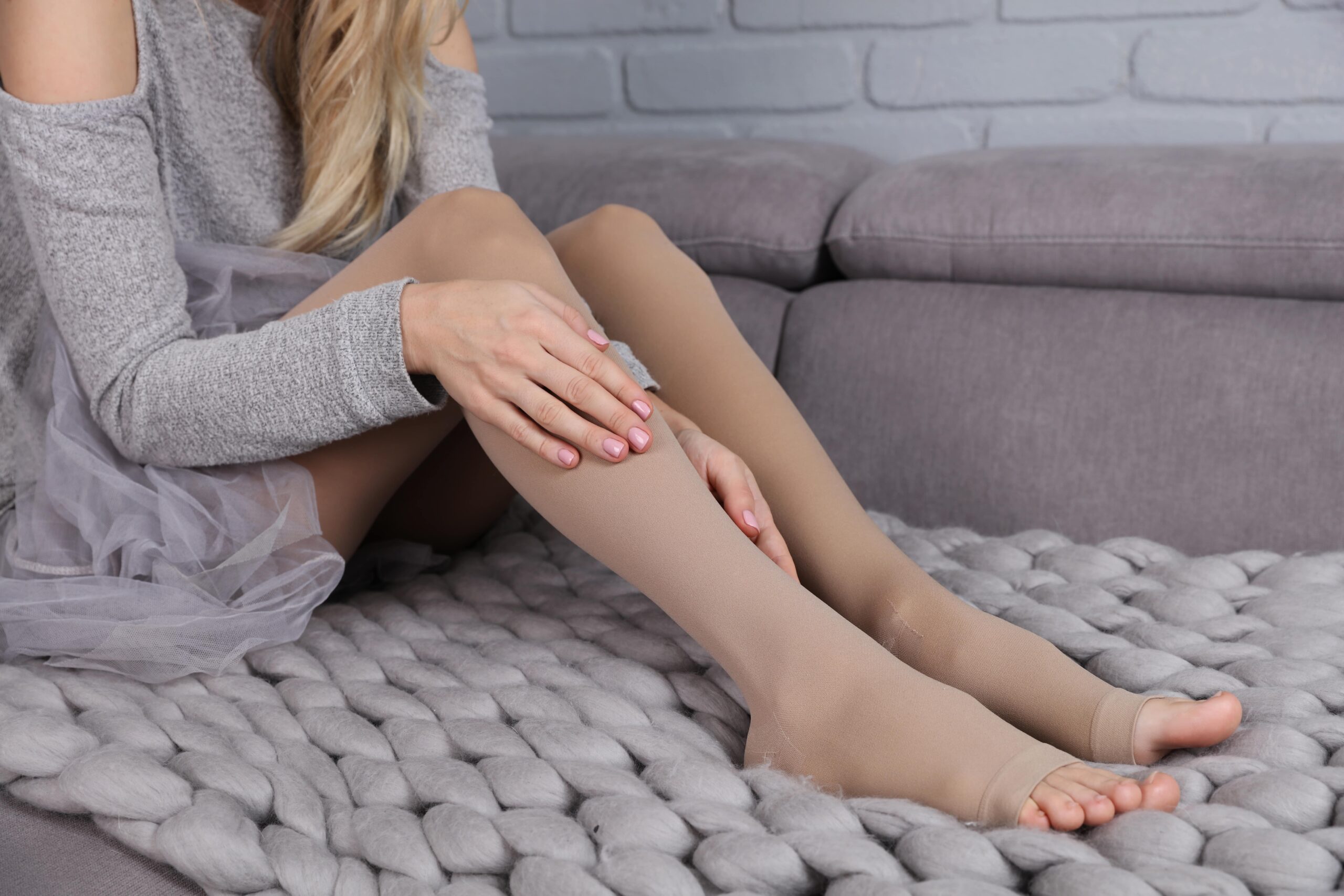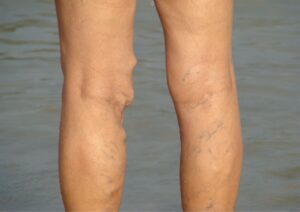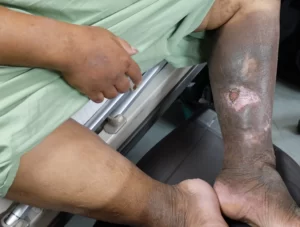Varicose veins are a common condition that affects many people, particularly as they age. While often not a serious medical issue, varicose veins can cause discomfort, pain, and swelling in the legs.
Varicose veins belong to the spectrum of chronic venous insufficiency. Graduated compression stockings or compression therapy are a non-invasive treatment option that can help alleviate the symptoms of varicose veins and chronic venous disease by improving blood flow in the legs.
However, like any medical treatment, graduated compression stockings have both benefits and risks. In this article, we will explore the benefits of graduated compression stockings for treating varicose veins, as well as the potential risks and drawbacks of using them as a treatment option.
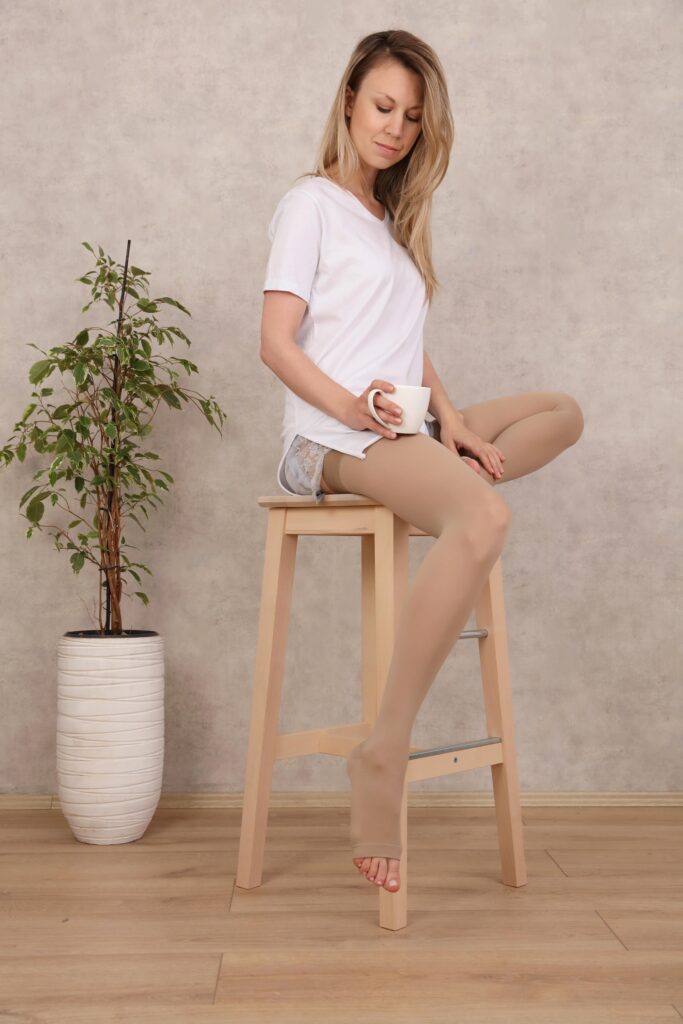
What is Medical Compression?
Compression therapy is a technique that uses pressure to improve blood circulation and reduce chronic build up of swelling and venous hypertension in a specific area of the body.
It is commonly used to treat conditions such as varicose veins, chronic venous diseases, lymphoedema, venous hypertension and deep vein thrombosis.
Compression therapy can be achieved through the use of compression garments, such as stockings, sleeves, and bandages, which apply pressure to the affected area.
The pressure from the compression helps to improve blood circulation by helping veins and lymph vessels to move blood and fluid back towards the heart more efficiently.
Medical compression is also used to prevent blood clots, reduce the risk of post-surgical complications, improve venous ulceration and promote healing in injured tissues.
The use of medical or compression therapy should be prescribed by a healthcare professional and allied health, who can help determine the appropriate level of compression and type of compression garment needed for initial treatment of the specific condition being treated.
How do medical-grade compression stockings help varicose veins?
Using compression stockings is often recommended as a first-line treatment for varicose veins because they help to improve circulation and reduce the pressure in the veins in the lower legs.
Varicose veins occur when the valves inside the veins do not function properly, causing blood to flow backwards and the blood pooling in the veins. This leads to chronic venous insufficiency which manifests with swelling, discomfort, and visible bulging veins.
Compression stockings work by applying graduated pressure to the legs, with the highest pressure at the ankle and gradually decreasing towards the thigh.
This helps to improve circulation by helping the veins to move blood back towards the heart more efficiently and ease swelling.
The graduated compression used also helps to reduce the diameter of the veins, which helps to reduce the pressure in the veins and prevent blood from pooling.
Graduated compression stockings are designed to provide a specific level of compression that is measured in millimetres of mercury (mmHg).
The appropriate level of compression for varicose veins depends on the severity of the condition and is typically prescribed by a healthcare professional.
Wearing compression stockings regularly can help to improve symptoms of varicose veins, including swelling, aching, and fatigue in the legs.
However, compression stockings do not cure varicose veins and should be used as part of a comprehensive varicose vein treatment plan that may include lifestyle changes, other medical treatments and procedures, or a combination of both.
What are the mechanisms of action of compression stockings?
Compression stockings work by applying graduated pressure to the legs, with the highest pressure at the ankle and gradually decreasing towards the thigh. This creates a pressure gradient that helps to improve circulation and reduce the pressure in the veins.
The main mechanisms of action of compression stockings are:
1. Promoting venous blood flow: Compression stockings apply pressure to the veins in the legs, which helps to improve blood flow by compressing the leg veins and promoting the movement of blood back towards the heart. It also assists with ulcer healing and DVT prevention on bedridden patients.
2. Reducing venous pressure: By compressing the veins, compression stockings help to reduce the diameter of the veins, which in turn reduces the blood pressure from inside the veins. This helps to further venous disease and prevent blood from pooling and causing further damage to the veins.
3. Reducing edema: Compression stockings can help to reduce swelling (edema) in the legs by increasing the pressure on the tissues and promoting the movement of fluid out of the tissues and back into the bloodstream.
4. Improving lymphatic drainage: The pressure created on blood vessels by compression stockings can also help to improve lymphatic function by promoting the movement of lymph fluid through the lymphatic vessels.
Overall, the use of compression stockings helps to improve circulation and reduce the symptoms of venous insufficiency, including pain, swelling, and fatigue in the legs. Compression stockings are commonly used to treat a variety of conditions, including varicose veins, deep vein thrombosis, and lymphedema.

How is the strength of compression graded?
The strength of compression in medical-grade compression stockings is typically graded based on the amount of pressure exerted on the leg, which is measured in millimeters of mercury (mmHg). There are four main levels of the graduated compression stockings:
1. Mild compression (8-15 mmHg): This level of compression is often used for mild venous insufficiency, minor swelling, and to help prevent blood clots during long periods of sitting or standing.
2. Moderate compression (15-20 mmHg): This level of compression is often used for mild to moderate venous insufficiency, varicose veins, and to help prevent blood clots during travel or after surgery.
3. Firm compression (20-30 mmHg): This level of compression is often used for moderate to severe venous insufficiency, varicose veins, and to treat leg ulcers.
4. Extra-firm compression (30-40 mmHg): This level of compression is used for severe venous insufficiency, lymphedema, and to treat mild chronic venous disease.
The level of compression needed to wear stockings for each individual depends on the severity of their condition and is determined by a healthcare provider. It is important to note that wearing compression stockings with a higher level of compression than necessary can be uncomfortable and even harmful, so it is important to follow the recommended guidelines for compression strength.
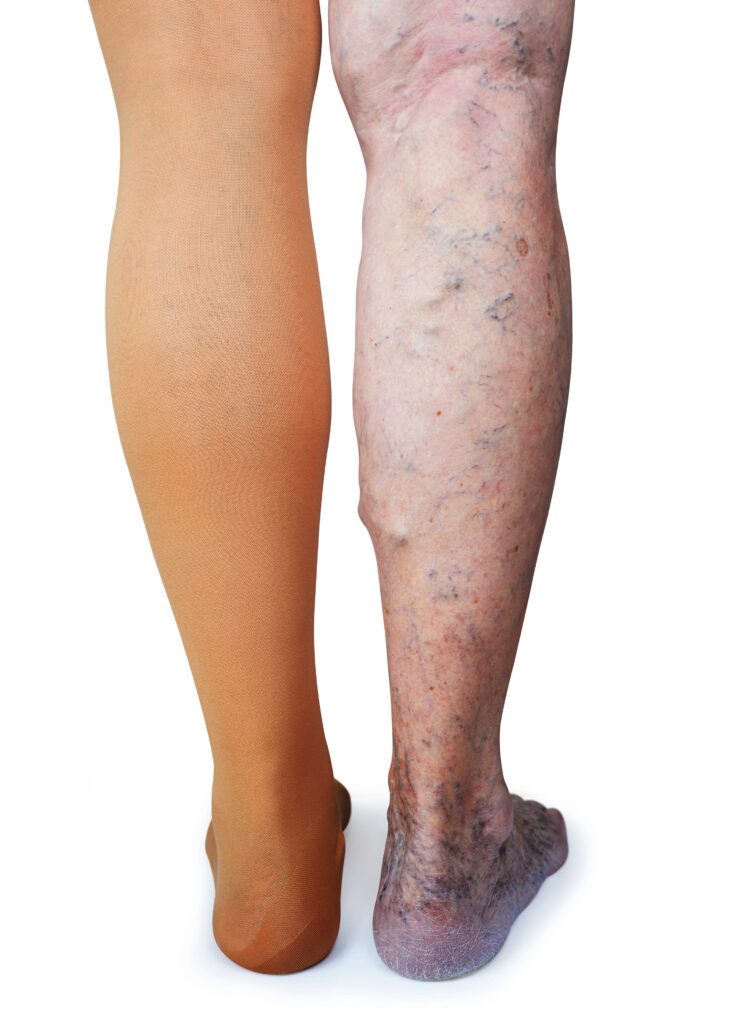
Types of compression stockings
There are several types of compression stockings available, each with unique features and intended uses. Some common types of compression stockings include:
1. Knee-high stockings: These stockings cover the foot and calf up to the knee and are typically used to treat mild to moderate varicose veins, swelling, and tired, achy legs.
2. Thigh-high stockings: These stockings cover the foot, calf, and thigh and are typically used to treat more severe varicose veins, deep vein thrombosis, and lymphedema.
3. Pantyhose: These stockings cover the entire leg and may also provide compression to the abdomen and hips. They are often used to treat more severe venous insufficiency, lymphedema, and deep vein thrombosis.
4. Compression sleeves: These are designed to provide compression to the arm and may be used to treat lymphedema or to prevent blood clots after surgery.
5. Compression socks for athletes: These stockings are designed to provide targeted compression to specific areas of the foot and leg to improve circulation during exercise and reduce muscle fatigue.
6. Anti-embolism stockings: These stockings are typically used in the hospital setting to prevent blood clots in patients who are immobile or recovering from surgery.
Compression stockings are available in a variety of compression levels and materials, so it is important to consult with a healthcare provider to determine which type of low compression of stocking is most appropriate for an individual’s specific needs.
Conclusion
Wearing compression stockings offers several benefits for individuals with certain medical conditions or those at risk of poor circulation.
These specially designed garments can help improve blood flow, reduce swelling, and alleviate symptoms associated with varicose veins, deep vein thrombosis, and lymphedema.
Additionally, compression stockings can provide relief and support during long periods of standing or sitting, such as during travel or work.
However, it’s important to consult with a healthcare professional to determine the appropriate compression level and size for your specific needs.
While compression stockings are generally safe, there are a few potential risks to be aware of, including skin irritation, pressure sores, and decreased circulation if improperly fitted.
It is crucial to follow proper usage instructions and regularly assess the condition of the stockings to ensure optimal effectiveness and safety.
Overall, with proper guidance and use, compression stockings can be a valuable tool in promoting leg health and enhancing overall well-being.
FAQ
While compression socks are generally considered safe for most people, compression socks present some potential downsides to wearing them:
1. Discomfort:
Some people may find high compression socks uncomfortable or restrictive, especially if they are not properly fitted.
2. Skin irritation:
Wearing compression socks for long periods of time may cause skin irritation or chafing, especially if the compression socks are too tight or made from an irritating material.
3. Difficulty putting them on:
Compression socks can be difficult to put on, especially if they have a high level of compression or if an individual has limited mobility or strength.
4. Contraindications:
There are some medical conditions that may make wearing compression socks unsafe, such as severe peripheral artery disease, acute congestive heart failure, or severe skin infections.
It is important to talk to a healthcare provider before starting to wear compression socks to make sure they are appropriate for an individual's specific needs and medical history. It is also important to make sure the compression socks are properly fitted and worn as directed to minimize the risk of complications.
Yes, wearing compression socks is a common and effective way to manage the painful symptoms because of varicose veins and associated chronic venous diseases. Compression socks work by providing graduated compression for aching legs, meaning they are tighter at the ankle and gradually loosen as they move up the leg. This helps to improve blood flow in the legs and reduce swelling, pain, and discomfort associated with varicose veins and chronic venous disease.
Medical-grade compression stockings are typically recommended for individuals with varicose veins and pregnant women as they provide the necessary amount of pressure to help manage symptoms. These stockings can be purchased over-the-counter or through a prescription from a healthcare provider.
It is important to note that while compression stockings can help to relieve symptoms manage the symptoms of varicose veins, they do not cure the underlying condition and do not treat varicose veins. For severe or persistent symptoms, medical treatment may be necessary to treat chronic venous disease, such as surgery or endovenous thermal ablation. Graduated compression stockings will need to be worn after the procedure as a part of the varicose vein treatment. It is best to consult with a health practitionner to determine the most appropriate course of treatment for an individual's specific needs.
While compression stockings are generally safe and effective for most people, there are certain situations where they may not be appropriate or could even be harmful. Here are some cases when you should avoid wearing compression stockings:
1. Poor blood circulation:
If you have peripheral arterial disease or other circulatory problems, wearing compression stockings could further restrict your circulation by compressing the blood vessels and exacerbate symptoms.
2. Skin infections:
If you have an active skin infection, open wound, or rash on your legs, wearing compression stockings could cause further irritation itchy skin and potentially worsen the infection.
3. Allergic reaction:
If you have a known allergy to any of the materials used in compression stockings, such as latex or nylon, wearing them could cause an allergic reaction.
4. Advanced heart failure:
If you have advanced heart failure, wearing compression stockings could lead to an increase in fluid retention and cause swelling in the legs.
5. Immobility:
If you are unable to move or have limited mobility, wearing compression stockings could increase the risk of blood clots or deep vein thrombosis.
If you have any concerns or medical conditions, it is always best to consult with your healthcare provider before wearing compression stockings.
Compression stockings have both pros and cons, which are listed below:
Pros:
1. Improve circulation: Compression stockings work by improving blood flow in the legs and reducing the risk of blood clots and other circulatory problems.
2. Reduce swelling: Compression stockings can help reduce swelling in the legs and ankles, which can be caused by conditions such as a varicose vein, veins or lymphedema.
3. Relieve pain and discomfort: Compression stockings can help relieve pain and discomfort associated with conditions such major veins such as varicose veins, deep vein thrombosis, and peripheral artery disease.
4. May help prevent certain medical conditions: Compression stockings can help prevent blood clots and venous ulcers, and may help reduce the risk of certain medical conditions such as varicose veins.
Cons:
1. Can be uncomfortable: Some people may find compression stockings uncomfortable or restrictive, especially if they are not properly fitted.
2. Skin irritation: Wearing compression stockings for long periods of time may cause skin irritation or chafing, especially if the stockings are too tight or made from an irritating material.
3. Difficulty putting them on: Compression stockings can be difficult to put on, especially if they have a high level of compression or if an individual has limited mobility or strength.
4. Cost: Medical-grade compression stockings can be expensive, especially if they are prescribed by a healthcare provider.
5. Contraindications: There are some medical conditions that may make wearing compression stockings unsafe, such as severe peripheral artery disease, acute congestive heart failure, or severe skin infections.
Overall, compression stockings can be an effective way to manage the symptoms of certain medical conditions, but it is important to talk to a healthcare provider to determine if they are appropriate for an individual's specific needs and medical history. It is also important to make sure the stockings are properly fitted and worn as directed to minimize the risk of complications.
Whether or not to wear compression stockings all day depends on the individual's specific needs and medical condition. In some cases, it may be recommended to wear compression stockings for the entire day especially to prevent varicose veins, while in other cases, it may be recommended to wear them only during certain activities or for a specific period of time.
It is important to talk to a healthcare provider to determine the appropriate duration and frequency of wearing compression stockings. The provider can also help ensure that the stockings are properly fitted and worn as directed to achieve the desired therapeutic effect while minimising the risk of complications.
Wearing compression socks during long flights is often recommended, especially for individuals who are at higher risk of developing blood clots or deep vein thrombosis (DVT).
When sitting for prolonged periods, blood flow in the legs can be reduced, which can increase the risk of developing blood clots. Compression stockings can help promote healthy blood flow, by applying gentle pressure to the legs and preventing blood from pooling in the veins.
However, it is always a good idea to talk to a healthcare provider before wearing medical compression stockings or socks during air travel, especially if you have any underlying medical conditions or concerns. They can advise you on the appropriate type of compression stockings and help ensure that they are properly fitted and worn as directed to minimize the risk of complications.

